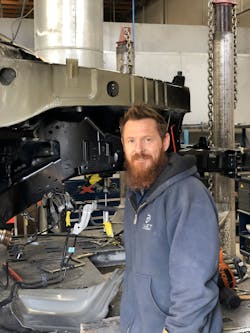Across the nation, businesses are dealing with a phenomenon many once thought impossible. There are a large number of open positions, with few job seekers looking to fill them. U.S. Department of Labor numbers from July show employers reporting more than 9 million open jobs. At the same time, roughly the same number of people looking for work declared they couldn’t find a job. There are many reasons for this disconnect. With so many available jobs, candidates are being more selective, taking their time to choose what work they want and making demands for remote work possibilities and the chance to work near home instead of relocating. In other cases, candidates are still worried about COVID-19 and are avoiding work that puts them at more potential risk (for example, working with the public or being in close proximity to others), or they prefer roles that allow them time to care for elderly or young family members.
Shops haven’t been immune from these issues. Ray Carrothers, owner of RC Autoworks in Tampa, says he spent months trying to hire a tech, detailers, and some office help with little luck. “I knew getting a good tech would be challenging, even before I tried to hire two who eventually decided to go elsewhere,” says Carrothers. “But I never guessed finding people to wash cars and do some light office administration would be this hard.” Carrothers adds that he’s heard some of his fellow repairers in the Sunshine State make similar claims.
What can a shop do in these conditions?
Repairers have a variety of resources to hire and make better staffing decisions in this environment and at any other time they need to add employees. Use the following five sourcing tips provided by staffing professionals and shops that have benefitting from better hiring strategies.
Tip 1. Don’t sleep on print ads.
You may be living in a digital age, but printed job ads have proven their worth in the collision market. Todd Herring recently started his tech career in the Cleveland area and chose his employer based on an ad in a local paper. Herring reports attending job fairs and applying online, but says the printed ad drew him to the shop because it was more impressive and direct. “They stated up front what they were looking for, what benefits they offered, and how long they were in business,” he says. Herring notes that the ad provided a phone number for a line to the hiring manager. With one call, he was able to find out more about the shop and set up an interview that week.
He’s not alone with his choice of ad type. Liz Gonzalez, a staffing professional with Find Work Now! says print ads can be particularly effective in certain niche markets, especially the service industry. She explains that service workers usually want to stick to a specific geographic area, which print media targets more effectively than nationwide online outlets. Also, many people still read print media. They are more likely to share a job ad with a friend or family member they saw in a local publication instead of one from the Internet.
“Trade and industry publications can be very effective since they provide jobseekers with the image of a highly professional business that’s active in its trade,” Gonzalez adds. Print ads can be expensive, she cautions, but Gonzalez notes that waiting for the right candidate to apply online can be even more costly.
Tip 2. Respond to every job inquiry.
Apart from trade and local publications, Gonzalez says industries like collision repair are best served with a combination of hiring outreach, including online outlines, their own Web sites and social media. Wherever your shop does business, you should feature a hiring effort. But advertising is simply the first part of any hire. Just as important is responding to all interest. Many shops still struggle with efforts to do business online. They don’t handle requests for estimates, service, and other information efficiently at all. When they fail, interested customers go elsewhere. The same is true with hiring inquiries.
Mike Workman, owner of Detroit-based Top Quality Autobody, says every inquiry should be answered, whether it’s received via email, a call, a resume submitted online or by mail, or a candidate applying directly at the shop. “You have to set aside time for perspective employees the same way you would for perspective customers,” he states. Workman recommends dedicating time during weekly management meeting to discuss hiring needs and reviewing candidate inquiries. “Preferably, call or email anyone showing interest and set up some time to discuss their abilities and interests and answer questions about your shop and available positions,” he says.
During a formal interview, make every effort to promote your shop, even if you don’t hire the candidate, he says. Workman notes that interviews are an opportunity to promote your business to a candidate, something you should be doing with every encounter with the public. He says that even if a candidate isn’t hired or doesn’t accept an offer, he or she should come away with high praise for your operation: “We work in a small industry. People talk. A candidate could very well recommend your business to someone else, even if he doesn’t find a landing spot.”
One final note: help is available for managing the hiring process. A number of new software tools can assist with responding to applications, collecting information and setting up interviews.
Tip 3. Get assistance from employees and customers.
Candidate referrals have long been effective way to locate new employees, with many businesses turning to this hiring method first. When you’re looking for help, begin by asking your current staff for referrals. Don’t stop there. Gonzalez says you should offer financial incentives. Pay hiring bonuses (possibly in the $200 - $500 range) for specific roles, with more being offered for harder-to-fill positions. Employees collect bonuses if a referral is hired and remains at the shop for six months.
Consider offering similar payouts to customers who do the same. Every person who walks through your doors or does business with you may know a perfect candidate or might just be your next great hire.
Tip 4. Turn to contracting firms.
With many workers preferring to take on temporary gigs to test the water at multiple employers or wanting to find work quickly, turning to staffing firms can offer some attractive hiring possibilities. They can take over your employee search and both locate and check the suitability of candidates for a particular role. They also can perform these tasks quickly and send candidates your way, sometimes within a day. The one downside here is cost, since you’ll likely pay a premium price to cover the staffing firms’ expenses. Carrothers took this approach with his front office and detailers. He says the experience was positive and recommends it to shops who are losing work or efficiency due to employee shortages.
“We had temporary workers in place within one week after requesting help from the firm. We were pretty confident with who they recommended, since they checked their background and did some of the interviewing,” Carrothers says. He additionally notes that most of the candidates the firm recommended were interested in moving to in-house employment, giving him a solid option for filling the positions long term.
Tip 5. Always be hiring.
In the June 2021 edition of ABRN (“Five Steps to Producing Painters for Your Collision Repair Shop”), experts from automotive refinish companies discussed ways to source new painters. Nearly everyone recommended creating a bench of new painters – regularly training and producing painters from your current staff. Gonzalez says a similar approach would greatly help repairers source other members of their staff. “The worst time to begin looking for new workers is after finding you need them - when you’re going to be caught short,” she says. “Instead, you should be training and promoting your staff from within to take on new roles.”
Building from within begins with conducting regular employee reviews and evaluations to identify skill sets and set goals. From there, Gonzalez says shops should create an overall staff strategy that aligns business goals with those of the employee to ensure a business’s growth is supported by the career growth of its staff. For example, estimators, techs and painters could be encouraged to move into management roles while detailers, helpers and office staff are trained for tech and painter roles (though there should be no limits here).
Business growth is further fostered by outside hires who are brought in mainly for entry-level positions. Gonzalez notes, “This way you aren’t forced to look outside for the hardest-to-fill jobs. Instead, you’re sourcing outside hires for positions they can pick up more quickly and that can put them on a path for a long-term career at your business, which is far easier to do.”
Any approach that takes some of the strain out of staff sourcing, or any other shop task, is welcome. That’s ultimately what these tips provide. There are great workers everywhere who would be welcome in your operation – from the young person graduating tech school to the server who brought you lunch, or the energetic person who is just looking for a chance to excel from the right employer. Your task is identifying these folks, training them and then growing their careers, every step of which benefits your business. Even when a trend in the employment market makes this task more difficult, with the right approach you can maintain a stable staff. That starts with creating a sourcing strategy that keeps you ahead of the game instead of one step behind in a race to build a team that keeps the work flowing.
About the Author

Tim Sramcik
Tim Sramcik began writing for ABRN over 20 years ago. He has produced numerous news, technical and feature articles covering virtually every aspect of the collision repair market. In 2004, the American Society of Business Publication Editors recognized his work with two awards. Sramcik also has written extensively for Motor Age and Aftermarket Business World. Connect with Sramcik on LinkedIn and see more of his work on Muck Rack.
